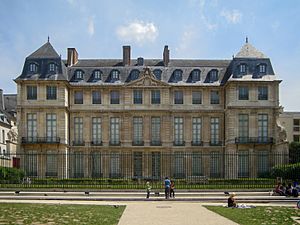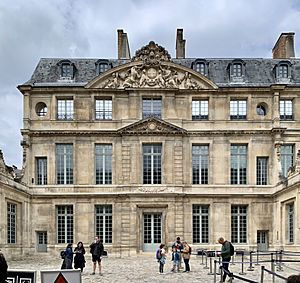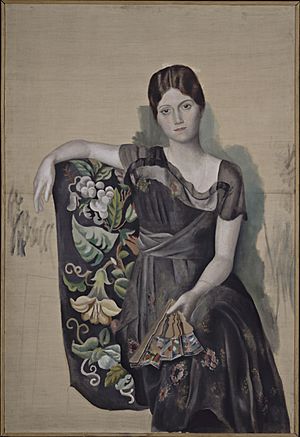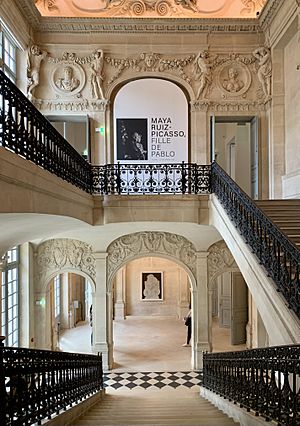Musée Picasso facts for kids


The Musée Picasso is a famous art gallery in Paris, France. It's located in a beautiful old building called the Hôtel Salé. This museum is all about the amazing art of Pablo Picasso, a Spanish artist who lived from 1881 to 1973. He spent most of his life in France.
The museum has more than 5,000 pieces of art by Picasso. This includes paintings, sculptures, drawings, and even ceramics. It also has thousands of items from Picasso's personal collection, like his photos, letters, and notebooks. Many of these artworks were given to the museum by Picasso's family after he passed away, just as he wanted.
Contents
The Hôtel Salé: A Historic Home for Art
The grand building where the museum is, called an hôtel particulier (which means a large private mansion), was built a long time ago, between 1656 and 1659. It was made for a rich man named Pierre Aubert. He made his money by collecting a special salt tax, which is why the building is called "Salé" (meaning "salted"). The architect who designed it was Jean Boullier.
A Mansion's Many Lives
Over the years, the mansion was owned by many different people. It was even the embassy for the Republic of Venice in 1671. During the French Revolution, the government took over the building. In 1815, it became a school where the famous writer Balzac once studied. Later, it housed other schools, including one for arts and crafts.
The City of Paris bought the mansion in 1964. It was recognized as an important historical building in 1968. Experts then worked to restore the mansion to its original grand look between 1974 and 1980.
Choosing the Museum's Design
After much discussion, the Hôtel Salé was chosen to be the home of the Musée Picasso. A competition was held to decide who would design the museum's inside. In 1976, the plan by Roland Simounet was chosen. He worked to bring back the mansion's spacious feel, even though it had been changed a lot over the years.
Picasso's Amazing Art Collection
How the Collection Was Formed
In 1968, France created a special law. It allowed families to pay inheritance taxes with valuable artworks instead of money. This is called a dation. It's only allowed if the art is very important to France's culture.
After Picasso passed away, his family used this law. They donated many of his artworks to the museum. These pieces show Picasso's work from all his different periods and in many styles. The museum has an especially great collection of his sculptures. Later, after Picasso's last wife, Jacqueline Roque, passed away, her daughter also donated more art. The museum has also bought many artworks and received gifts over time.
What You Can See in the Museum
Picasso once said, "I am the greatest collector of Picassos in the world." He had collected a huge number of his own artworks by the time he died in 1973. These included everything from small sketchbooks to famous masterpieces.
The Musée Picasso now holds over 5,000 of his artworks. This includes 3,700 works on paper, ceramics, sculptures made of wood and metal, and paintings. The museum also has Picasso's own personal art collection. This includes works by other famous artists like Renoir, Cézanne, Degas, and Matisse. You can also see some ancient Iberian bronzes and a good collection of African art. Picasso was greatly inspired by African art in his own work.
Exploring the Artworks
The museum mostly shows Picasso's art in the order it was created. You can see his paintings, drawings, sculptures, and prints. There are also photographs, letters, and newspaper clippings. These help you understand more about Picasso's life and his art. The museum even shows cartoons that made fun of Picasso's work in the 1950s!
The second floor has a special area for temporary exhibitions. These are shows that change over time. The third floor has a library and research areas for people studying Picasso.
Museum Operations and Funding
How the Museum Is Funded
More than 5,000 artworks were given to the museum by Picasso's family after his death in 1973. This was done through the special law that allows art to be given instead of tax payments. More donations came from the family of Picasso's last wife, Jacqueline Roque. Since 1985, the museum has also bought over 1,000 more artworks.
The museum has found creative ways to get money. For example, it sent artworks on tour to other countries for exhibitions. This helped raise money for the museum's big renovation. The "Masterpieces from the Picasso Museum" tour earned millions of euros between 2008 and 2011. This tour helped pay for the museum's updates.
Reopening and Expansion
The museum closed for a big renovation project in 2009. This project aimed to almost triple the public space inside the museum. It involved moving staff offices to a new building. The renovation took longer and cost more than expected.
After being closed for five years, the museum finally reopened on October 25, 2014.
See also
 In Spanish: Museo Picasso de París para niños
In Spanish: Museo Picasso de París para niños
- Museu Picasso (Barcelona)
- Museo Picasso Málaga
- List of single-artist museums



